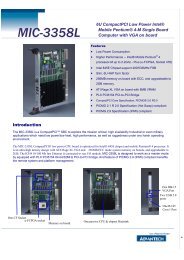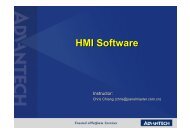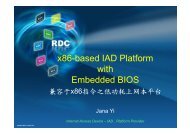industrial wireless book special edition - Networking ...
industrial wireless book special edition - Networking ...
industrial wireless book special edition - Networking ...
Create successful ePaper yourself
Turn your PDF publications into a flip-book with our unique Google optimized e-Paper software.
IEEE 802.11p MAC protocol for vehicle ad-hoc networks – VANETs<br />
Vehicular Ad-hoc Networks (VANETs) have emerged as a key underlying technology in the realisation<br />
of Intelligent Transportation Systems (ITS). Vehicle communications can greatly reduce the incidence<br />
of accidents. One application is the Intelligent Transportation System (ITS) that includes automatic<br />
control services for improving safety, reducing traffic congestion and increasing passenger comfort.<br />
Although VANETs are particular cases of the general mobile ad-hoc networks, they possess some<br />
characteristics that make its nature exclusive – and present challenges that require a set of new<br />
protocols. Vehicle speeds can be up to 150km/h, while the network topology changes repeatedly<br />
and unpredictably. Hence, the time duration for which a link is active between the vehicles is very<br />
short, e<strong>special</strong>ly when the vehicles are travelling in opposite directions.<br />
One approach to enlarge the lifetime of links is to increase the transmission power, but increase<br />
in a vehicle’s transmission range will result in increasing the probability of data collision and cause<br />
degradation in the overall system throughput. The other solution requires new protocols exhibiting<br />
a very low latency.<br />
The usefulness of the broadcasted messages depends on latency. For example, if a vehicle is<br />
stopping or suddenly stops, it should broadcast a message to warn other vehicles of the probable<br />
danger. Considering that the driver needs at least three quarters of a second to initiate a response,<br />
the warning message should be delivered with virtually no system latency.<br />
Position of nodes changes quickly and unpredictably in VANETs, so that, building an efficient routing<br />
table or a list of neighbour nodes will tire out the <strong>wireless</strong> channel and reduce the network efficiency.<br />
Protocols that rely on prior information about location of nodes are likely to have a bad performance.<br />
However, the topologies of a VANET can be an advantage because the vehicles are not<br />
expected to leave the covered road; therefore, the running direction of vehicles is predictable to<br />
some level. Privacy, safety and security fundamentally affect public acceptance of the technology.<br />
With VANETs, each node corresponds and reports a specific person and location.<br />
Implementation<br />
VANETs involve both vehicle-to-vehicle (V2V) and vehicle-to-infrastructure/roadside (V2I or V2R)<br />
communications that rely on short-to-medium-range communication techniques.<br />
The IEEE-1609 set of standards for Wireless Access in Vehicular Environments (WAVE) specifies an<br />
architecture that includes new standards for vehicle communication aimed at supporting ITS applications.<br />
IEEE-802.11p forms the bottom layers of the WAVE protocol stack and contains MAC and<br />
PHY layers derived from IEEE-802.11a. This makes IEEE-802.11p more suitable for high speed<br />
vehicles. The WAVE protocol forms a LAN to facilitate ITS applications; this LAN defines a WAVE Basic<br />
Service Set (WBSS) comprising vehicle on-board units plus roadside units.<br />
The IEEE-802.11p MAC protocol is derived from the IEEE-802.11 distributed coordination function<br />
(DCF), and also uses the IEEE802.11e EDCA based quality-of-service (QoS) amendments. 802.11<br />
MAC uses CSMA/CA that is specified in almost all variants of IEEE-802.11 (802.11a, 802.11b,<br />
802.11g and 802.11p). RTS (Request-To-Send) and CTS (Clear-To-Send) mechanisms are used to<br />
resolve hidden and exposed node problems (such as found in vehicle movements).<br />
In IEEE-802.11p, both the MAC (medium access control) and the PHY (physical) layers belonging<br />
to the DSRC/WAVE protocols are enhanced. Except for slight parameter changes to enable high user<br />
mobility, the IEEE-802.11p physical layer is identical to IEEE-802.11a. Moreover, the transmission<br />
power may be higher (up to +44dBm) in 802.11p compared to that in 802.11a. IEEE-802.11p MAC<br />
layer is derived from the basic IEEE-802.11 DCF.<br />
The operating frequency for IEEE-802.11p is the 5.85-5.925GHz range in the licensed 5.9GHz ITS<br />
band. For safety applications requiring higher priority, one channel is dedicated to control. Other<br />
channels are service channels that can serve safety and non-safety services.<br />
The function of the MAC is to coordinate the use of the communication medium. MAC layer protocols<br />
decide which node will access the shared medium at any time. As safety critical applications are<br />
designed to alert drivers about immediate danger, therefore requiring tight delay bounds, a MAC<br />
protocol has to take into consideration these strict application requirements.<br />
A study<br />
The focus of a paper 1 on which this box is based is a performance analysis of the IEEE-802.11p<br />
MAC protocol. In the paper, the IEEE-802.11p MAC method was evaluated by developing a VANET<br />
model using MATLAB simulations. The scenario included time-critical packets periodically broadcast<br />
in V2V communications. Channel access delay and the probability of channel access were evaluated.<br />
It was found that when the number of vehicles increased from 100 to 200, channel access delay<br />
increased by around 20ms, and the probability of channel access decreased by about 5%. More<br />
vehicles meant a greater chance of collision, as vehicles have less chance to access the channel.<br />
Moreover, increasing the VANET sensing range from 500 to 1000m reduced channel access probability<br />
by 35%.<br />
The work showed that VANET performs well in small ranges because it becomes easy for vehicles<br />
to communicate with each other. Physical interference and the probability of hidden terminals also<br />
decreased, because in small ranges vehicle location is more likely to be known to other vehicles.<br />
Finally, when simulation times were varied between 50 to 80ms, the probability of vehicles accessing<br />
channels increased by 15%.<br />
1. Performance Evaluation of IEEE 802.11p MAC Protocol for VANETs; Shahzad A. Malik, Madad Ali<br />
Shah, Shahid A.Khan, M.Jahanzeb, Umar Farooq and Adnan Khan. Australian Journal of Basic and<br />
Applied Sciences, 4(8): 4089-4098, 2010.<br />
Transportation<br />
Fig. 2. On Board Units (OBUs) and the Roadside Units (RSUs) were designed for the<br />
demonstrator. These are based on embedded hardware and real-time Linux. The vehicle<br />
OBU communicates with the traffic signal, so drivers know when the next signal change<br />
occurs, allowing time to adjust driving and route accordingly. This can reduce traffic<br />
congestion.<br />
be displayed on the OBU. The OBUs and RSUs transmit beacons at regular<br />
intervals. To avoid placing an unnecessary load on the network, connections<br />
are established only on demand.<br />
Security<br />
The different scenarios call for a reliable and robust communication<br />
platform to ensure that the entire system will be unaffected by local<br />
sponsored by Advantech<br />
<strong>industrial</strong> ethernet <strong>book</strong><br />
disruptions and interference. A security concept must also be developed<br />
to exclude attacks and manipulation. At the forefront are data security,<br />
authentication and data integrity, issues that can be addressed through<br />
encryption, digital signatures and certificates.<br />
The deployment of a public key infrastructure is costly and, as a result,<br />
cannot be efficiently implemented on low-cost hardware. Even so, the<br />
system must guarantee the anonymity of the driver. This can be achieved<br />
by using temporary and revocable pseudonyms.<br />
The advantages<br />
In contrast to car-to-car communication, car-to-roadside communication<br />
delivers advantages as soon as the first vehicle is equipped with<br />
the technology. No minimum penetration rate is called for. The benefits<br />
lie mainly in extra safety, better traffic management and good access<br />
to information and entertainment.<br />
Improved traffic flow – Because the vehicle OBU communicates with<br />
the traffic signal, the driver knows when the next signal change occurs,<br />
allowing him/her to adjust driving and/or route accordingly. This can<br />
reduce traffic congestion.<br />
Increased safety – Vehicle sensors register accidents and their severity.<br />
The vehicle transmits the accident information to the next RSU and a<br />
high-priority emergency call is disseminated throughout the mesh<br />
network. This warns other drivers in the vicinity of the accident, or<br />
forwards the accident report to emergency services control centres, such<br />
as police, fire and rescue services.<br />
More convenience – Service stations supply the RSUs with up-to-date<br />
fuel prices and hours of operation and forward the data to RSUs in their<br />
vicinity. The vehicle can query the data for all service stations located<br />
along the planned route and display the service station with the best<br />
prices on the OBU.<br />
Fraunhofer ESK offers concepts based upon fault-tolerant <strong>wireless</strong><br />
15

















